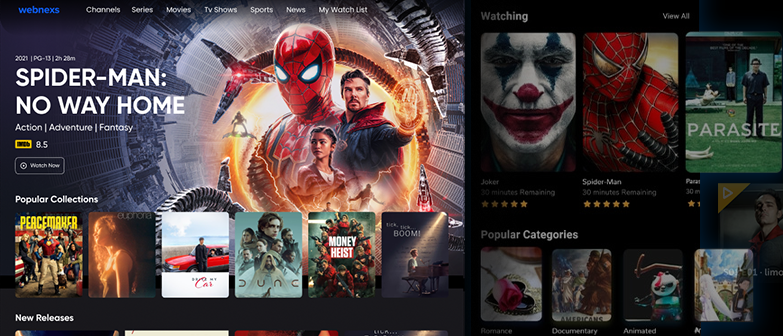Introduction
In this digital era, streaming video have revolutionized the way we consume entertainment content. Two popular options are OTT (Over-The-Top) and VOD (Video-On-Demand) platforms. Both have their unique characteristics and benefits. In this article, we will explore the differences between OTT and VOD, their impact on the entertainment industry, and which one might be the better choice for your viewing preferences.
Understanding OTT (Over-The-Top)
OTT refers to the delivery of video and audio content over the internet, bypassing traditional cable or satellite providers. Users can access OTT content directly through the internet, making it convenient and accessible on various devices like smartphones, smart TVs, tablets, and computers. Leading OTT platforms like Netflix, Hulu, and Amazon Prime Video offer a vast library of movies, TV shows, and original content.
Understanding VOD (Video-On-Demand)
VOD, on the other hand, is a model that allows users to select and watch video content whenever they desire. It offers a vast catalog of movies, TV shows, and other content that users can choose from, paying only for what they want to watch. VOD platforms like iTunes and Google Play Movies enable users to rent or purchase individual titles, granting them the flexibility to watch content on their terms.
Key Differences Between OTT and VOD
-
Content Delivery: OTT delivers content over the internet, while VOD allows users to choose content from a library and watch it at their convenience.
-
Business Model: OTT typically requires a subscription fee for access to a library of content, while VOD operates on a pay-per-view or rental basis for specific titles.
-
Content Selection: OTT platforms offer a wide range of content, including movies, TV shows, documentaries, and original productions. VOD platforms provide a vast collection of individual titles that users can rent or buy.
-
Accessibility: OTT content can be streamed on various devices, promoting mobility and instant access. VOD content is also accessible on different devices, but users pay for each specific title they choose to watch.
The Growth of OTT and VOD Services
The popularity of OTT and VOD services has soared in recent years due to several factors. The increasing adoption of smartphones and high-speed internet has facilitated easy access to streaming content. Additionally, the freedom to watch content on-demand without being tied to a fixed schedule has resonated with audiences worldwide. As a result, OTT and VOD platforms have experienced exponential growth, challenging traditional broadcasting models.
Pros and Cons of OTT
Pros:
- Diverse Content Selection: OTT platforms offer a wide array of content, catering to various interests and demographics.
- Original Content: Many OTT services produce high-quality original shows and movies, attracting subscribers with exclusive content.
- Convenience: Users can stream content on multiple devices, enabling them to watch their favorite shows on the go.
Cons:
- Subscription Costs: Some OTT platforms may have monthly subscription fees, which can add up if users subscribe to multiple services.
- Internet Dependence: OTT requires a stable internet connection, which might be a limitation in areas with poor connectivity.
Pros and Cons of VOD
Pros:
- Flexibility: Users have the freedom to choose individual titles they wish to watch, paying only for what they consume.
- Recent Releases: VOD platforms often make new movie releases available for rental or purchase shortly after their theatrical release.
- No Subscription Commitment: Users can use VOD services without the need for a monthly subscription.
Cons:
- Limited Library: VOD libraries may not offer the vast selection of content found on OTT platforms.
- Rental Costs: Renting multiple titles can become expensive, especially for users who frequently watch movies.
How OTT and VOD are Changing the Entertainment Industry
The rise of OTT and VOD services has disrupted traditional media distribution channels. Cable and satellite TV providers are facing fierce competition from these streaming platforms. As a result, many cable companies have launched their OTT services to retain customers. The entertainment industry has also witnessed a surge in original content production, as OTT platforms invest heavily in creating exclusive shows and movies to attract and retain subscribers.
The Future of OTT and VOD
The future of OTT and VOD looks promising, with the ongoing advancements in technology and increasing demand for digital entertainment. These services will continue to expand their content libraries and improve user experiences. Moreover, as internet infrastructure improves globally, OTT will likely become even more accessible to audiences worldwide.
OTT vs. VOD: Which One is Right for You?
The choice between OTT and VOD ultimately depends on individual preferences and viewing habits. If you enjoy a vast selection of content and prefer the convenience of a subscription model, OTT might be the better option. On the other hand, if you prefer watching specific titles and want more control over your spending, VOD could be the ideal choice for you.
Conclusion
In conclusion, OTT and VOD have transformed the entertainment landscape, providing users with unparalleled flexibility and control over their viewing experiences. These
have redefined the way we consume content, allowing us to enjoy movies and shows whenever and wherever we want. As technology continues to evolve, the future of OTT and VOD appears promising, promising an ever-expanding world of entertainment at our fingertips.

